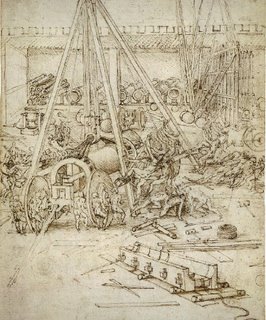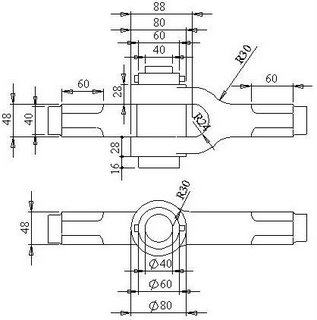Chapter 1
For last twenty thousand years, a drawing has been the principal means for portrayal of ideas through the use of lines. In ancient days people used to explain their ideas by marking in the dust on the floors of the caves and even today it is our one universal language, when our drawings are prepared by computers and plotters. The earliest human records are graphic, showing people, deer, buffalo and other animals of the time on the rock walls of caves. The drawings were to satisfy an elemental need for expression, long before the development of writing. Most of the very early drawings that still exist were made on parchment, which was very durable. Later during the twelfth century, paper was developed in Europe and came into general use for drawings.
Only a few of the earliest drawings for fortresses, buildings and simple mechanisms are in existence today. These are largely pictorial in nature, and they exist as carvings and paintings on walls of structures or have been woven into tapestry. One of the earliest representations shows the use of the wheel about 3200B.C. in Mesopotamia. The drawing presents a wheelbarrow like structure being used by a man to transport his wife or child. Also a ground-plan type of drawing for fortress exists on a tablet prepared about 400B.C.
Leonardo Da Vinci recorded his ideas and designs for war machines and mechanical constructions by preparing perspective sketched and drawings such as shown in figure (1.1). No multi-view drawing prepared by Da Vinci has been found. He knew the value of pictorial drawing and it is interesting that even today, we prepare pictorial drawings to supplement our other design drawings.
1.2 The usefulness of engineering drawing:
Drawing is a language and a language has great usefulness. We are familiar with the languages of written word, mathematics and music. They are used throughout the world so that people can communicate with one another. Whether a story is to be read, a song is to be sung or an equation is to express a physical truth, language is essential to understanding among people.

Fig (1.1): Sketch of artillery prepared by Leonardo Da Vinci (1452-1519)
Drawing is language that can be learned and used like any other. A drawing may be related to art, where creative expressions evolve a form unique to the particular artist. The results can be of great inspiration and pleasure to those who view the finished artwork. The language of engineering drawing developed within the book is of use to express ideas related to the making of products that can serve society. If one wishes to make a new type of chair, a plan or drawing needs to be made so that workers can understand what the designer has in mind for the chair.
Our object is to study the language of engineering drawing so that we can write it clearly for those familiar with it and read it readily when written by another. To do this, we must know its basic theory & be familiar with its accepted conventions & abbreviations.

Fig (1.2): Idea sketch of flying machine prepared by Leonardo Da Vinci (1452-1519)
1.3 The present & the future:
This is a period of revolutionary change in the field of engineering drawing. The emphasis on drawings to convey meaning efficiently has been enhanced by the widespread use of computers in engineering. The old saying that a picture is worth a thousand words has never had more meaning than in our present computer driven technological society. Computer aided design and drafting softwares are readily available in markets, which can make drawings and pictorial models with very less efforts. The changes can easily be made and thousands of drawings can be managed without much difficulty by the use of computers. A computer-generated drawing has been shown in fig (1.3).
For both forms i.e. for manual drawing or computer drawing, the person should have a thorough understanding of the drafting conventions that are explained in this book. The principles of projection, conventional practices for representation & dimensioning standards discussed in this book are still in effect & used constantly in the interpretation of computerized drawings.

Fig (1.3): A computer-generated drawing showing assembly of components
In present scenario computers can generate parametric drawings. In parametric drawings, the dimensions of objects can be changed according to the requirements without much difficulty, like length of a line, diameter of circle, height of cylinder or depth of hole. Constrains can also be applied to these drawings to restrict the dimensions.
The future seems to be driven by knowledge based design and drawings. As the designer makes products and drawing by getting expertise for a long time so the computer will monitor his methods and approached to design the product and record all his experience through programs. When a new design and drawings of the same component will be asked with little modifications, the computer itself will make the changes according to requirements and will make drawings. In knowledge based design and drawings, a circle can be replaced by a rectangle or a prism can be replaced by a cylinder, depending upon the requirements. So most of the routine design and drafting work will be done by computers.

